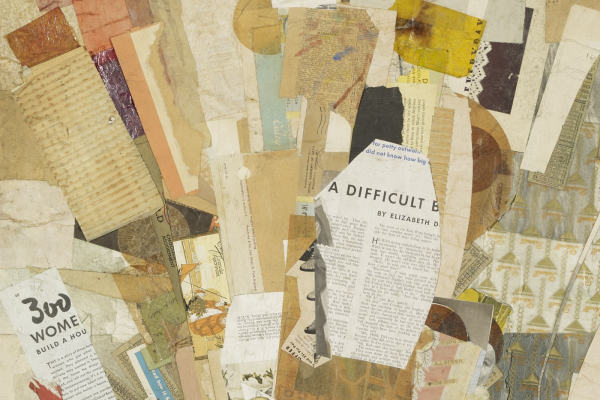Company of Moths
Michael Palmer
New Directions, $16.95 (paper)
Michael Palmer’s new book, Company of Moths, is as much about fellowship as about insects. To paraphrase John Ashbery on Elizabeth Bishop, Palmer is a writer’s writer to writers, and here he continues his dedication to dedications, directing many poems toward an international circle of writers (Faraj Bayrakdar, Pura López-Colomé, W.G. Sebald, et al.), often insisting on influence (“after Bandeira,” “after Drummond”), and sometimes beginning a poem in direct address (“Cupido, the frogs are singing” or “O Gerardo Deniz, tell me, if you know”). Not since that other gulf war–era volume, At Passages (1995), have we seen in Palmer this frequency of dedicated poems, this urgent sense of an international network not identical to a trade or military alliance, nor have there been so many poems titled “Untitled” (though almost always dated) since that book. It is as if names must be reserved for persons rather than poems at a time when the fragility of the former is never far from mind—dedication as not only filiation but memorial.
“Company” is also as much about bread (from the Latin com-, “with,” and panis, “bread”) as about fellowship—Robert Creeley’s “company of love,” which also depends on abstract bread (“Can I eat what you give me”), comes to mind. The word marks an etymological slide between the corporate and the corporal, between the company where bread is earned and the one where it’s broken together, perhaps suggesting that poetry is, among other things, that Eucharistic moment of conversion—business to bread and then to moths—that allows a virtual communion between poets and readers, or poets and other poets.
The moths, then, of this company, or “kingdom of words,” to quote the epigraph from Carlos Drummond de Andrade, are also mouths, literary mothers and others, units of encounter and provocation. To call the moth or company an unstable image would be incorrect. Each is, alone and conjoined, the capacious image, capable of emphasizing any of its associations and of transforming from one into another and back. The catalog of associations we could make between moth and writer (both are tropic, obsessional, have false eyes, aren’t wanted in houses, do their best work at night) or moth and book (they open and shut along a spine) is less interesting than the passage from one association to the next. That this company of moths not only names the book but appears as a section title within it, and that that section title itself appears in another section as a poem’s title, seems apt—the figure’s borders are open; the moth is a stage in a transformation, two pages in the book of a species, temporary, migrant, recursive.
Writers are part of that even larger company of readers, and in the second poem of the collection Palmer suggests that he is at that point in his career where he can address even his own poetry as if it were another’s (though this has probably been true since the beginning), reusing the phrase “Dearest Reader” (“Dearest Reader from the future-past”), which both appeared in and served as title for the first poem of First Figure (1984). While there is nothing new under the sun or after Sun (1988), there is still this projected reader to address and somehow please by variations. In a poem called “Night Gardening” late in the book, the poet makes a bad-faith promise to this reader both to be new and to be no longer the same:
A reader writes to complain
that there are no cellphones in my poems,
so here is one, its body chrome,
its face a metallic blue.
It’s neither transmitting nor receiving. A woman from Duluth requests
that I cease sending secret messages
to her in my poems. This I will do forthwith. And the blackbird at evening. She says, you have misrepresented the
river
there where it turns by the holm oak and the bed
of winter hyacinths. This I will correct.
But there is still no actual cell phone in the poem, the secret messages can’t be turned off, and the river remains uncorrected. There is a kind of admission of helplessness in much of Palmer’s wit, a helplessness that is by turns fecund and arid—he can’t help naming and renaming things, and this act, whose logic is infinite, creates all difference and makes it all alike: the plants in a garden at night.
Hence, many of the pleasures, even mannerisms, of the earlier Palmer are secreted here; this is both the blessing and the curse of keeping oneself company. There are broken or burning ships, as there always are, questions without question marks, a frequent insistence on the materiality of the book (ink, page, spine), and strange occupations (the “photophilographer” from The Promises of Glass (2000) is now a “pyrographer”). We find the satiric appeal to authority (“The play as they always say // of light and shadow”) as well as the cascade of synonymy, of proliferating names and questions, names as questions. A company of them is established in the first three lines of the book:
The ship—what was her name, its
name?
Was it The Moth? Or The Moth
that Electrifies the Night? Or The Moththat Divides the Night in Half
in its Passage toward the Fire?
(“And”)
And sudden, unadumbrated turns into a naturalist’s log:
(Are there still questions and questions
unasked
Dearest Reader from the future-past?)Berries brilliant orange on the hawthorn
this Wednesday late November
(“Of”)
My favorite of these signature inventions is much like the name-cascade above, but, rather than names or titles, we get the cross-section of a speculative inventory:
. . . Hashish, the tales it
tells, the scented oils and modern
festivals,
the sphinx-like heads and the shining
ornaments
for ankle, waist, neck and wrist,dioramas, cosmoramas, pleoramas
(from pleo, “I sail,” “I go by water”),
the hierophant in wax, the iron and
glass,the artificial rain and winds,
mosaic thresholds, all of this
bathed from above in diffuse light.
(“And”)
Mythic, intermittently plausible, the inventory describes the general operations of an ur-culture rather than producing a set of specific historical features—the sign of this is usually the litanic presence of the “the,” an articular style in which a cultural object’s status as symptom or example is emphasized over its peculiarity. Each becomes the obvious trait of a mysterious version of culture, one that only exists during its mention by a slightly bored docent. Again, as in “Night Gardening,” differences are all alike, although here a wish may be encoded alongside that idea: that the trivial differences of modern festivals, the controlled weather of the cosmorama or spectacle, lasted only as long as three stanzas of poetry do, or were as harmless. As “This” puts it:
This perfect half-moon
of lies in the capitalCrooks and fools in power what’s new
and our search has begun for signs of springMaybe those two bluebirds
flashing past the hawthorn yesterday
Again, the hawthorn ex machina allows us fantasized access to an inventory of something other than capital’s surfaces, even if it is a list occasioned by lies and quite brief (“flashing,” “yesterday”) and tentative (“Maybe”).
If the first two poems of the collection, “And” and “Of,” suggest conjunction and belonging, they are no different from the others, which think their way along the seam where the virtual community of world literature meets the material world of capital, violence, and hawthorns. This is the place where moth meets “moth,” an alienating “near turns to far.” The reverse is also true: another writer, dead or living, is just a poem’s distance off—“faraway-near,” as Palmer likes to say. His models of collectivity are not hermetic fantasies of another world saved from the depredations of this one, but moments where a writer exposes his figures as unfinished efforts at making the reader dear, remodeling this world as a place of mutual acknowledgment and collaboration among any group of persons, writers or not. “Hive” ends by asking, “Who speaks who listens who hears or sees,” and the absence of commas is instructive—these are parts of the continuous effort at an exchange in which it wouldn’t matter who speaks, an exchange that “the us /not us” and global “factories of blood” suspend or interrupt.
In Company of Moths these efforts of “Ghostly Tall and Ghostly Small / making their small talk” occur at the level of punctuation, syllable, and word. “Hive,” for example, mentions both “a tiny arc” and a “hive of woven glass”—put “arc” and “hive” together and you’ve got “archive,” that great insectoid collective out of which significations fly in arcs and into whose company they all parabolically return. And what do you know, earlier in the book there’s a poem titled “Archive,” and a little later, before “Hive,” a poem named “Arc.” Is this a secret message to the woman from Duluth? I’d say it’s more of a model kit sent out to reader-collaborators for assembly, one that allows you to build for yourself, speak listen hear or see for yourself, what another writer-reader did. In remembering how archive was made we become part of that brief collective, “those waters that once we bathed in / spine against spine,” part person and part book. Palmer’s genius has always been for figuring that immaterial passage between figures, from arc to hive, inside a company, without ever forgetting to remind us of its material basis in sound and lived experience. If you object that moths are isolates that don’t live in hives, this he will correct forthwith—they do; they’re called lit windows: “the transparent night, that / hive of woven glass.”







